
© » KADIST
Wolfgang Tillmans
Wolfgang Tillmans initiated the ongoing series Faltenwurf in 1989, representing compositions of unused clothing, with special attention paid to the ways in which they drape and fold. The title is taken from a Germanic term used in the context of art history, designating classical drapery. In this particular photograph, Faltenwurf (Stairwell) , an assortment of various colored clothes lay tangled on a set of stairs, as a sculpture of abstract forms.
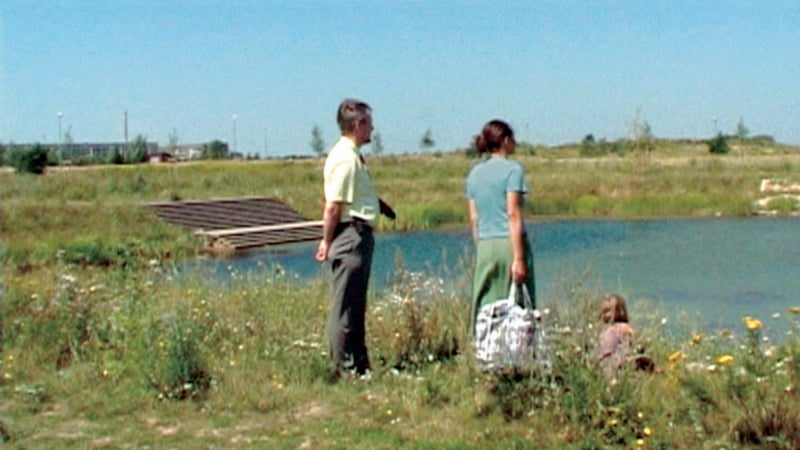
© » KADIST
Clemens von Wedemeyer
Die Siedlung is a filmic documentary about the recent shift in housing developments in Leipzig-Grünau in former East Germany and its consequences on some inhabitants. It complements von Wedemeyer slightly earlier and more artistic film Silberhöhe (2003) which decried imposed Modernist living model. In Die Siedlung , a voiceover describes and criticizes the different sites on view while the camera moves slowly past a vast abandoned 1930s Nazi army barracks which has yet to be converted or demolished, the building site and wastelands for the new private single family housing area, a constructed pond and finally the 1960s or 70s communal blocks of flats.

© » KADIST
Kota Ezawa
Paint and Unpaint is an animation by Kota Ezawa based on a scene from a popular 1951 film by Hans Namuth featuring Jackson Pollock. At first glance, due to the oversimplified silhouettes Ezawa employs, the connection between his animation and Namuth’s film may not be obvious. However, when seen side by side, Ezawa’s piece is a faithful reproduction of the scene—up until a point in which his sequence begins playing in reverse, effectively unpainting every brushstroke.

© » KADIST
Clemens von Wedemeyer
Clemens von Wedemeyer has imagined a trip back in time at Breitenau. Starting with events that happened there from 1933 to 1945, the German artist has composed three stories that reach the years of the women’s reformatory, in the 1970s, with a different protagonist for each era. A work that attempts to bring out the “pathology” of the site, as the artist tells Bert Rebhandl, and at the same time its “unforgettable” status as a black hole in the history of Germany, that sucked up innocent lives for almost a century.

© » KADIST
Kota Ezawa
The Simpson Verdict is a three-minute animation by Kota Ezawa that portrays the reading of the verdict during the OJ Simpson trial, known as the “most publicized” criminal trial in history. In 1995, OJ Simpson—a well-known American football player—was accused of the murders of his ex-wife Nicole Brown Simpson and her friend Ronald Goldman. Based on the courtroom footage, Ezawa uses his signature style to create an abstract and graphically simplified echo of what happened in the room.

© » KADIST
Annette Kelm
Drawing & Print (Drawing & Print)
Percent for Art is seemingly concerned with “art enrichment” by state or city arts agencies role in it, managing the artist rosters, maintaining public art collections, commissioning artworks, selecting installation sites, among other things for aesthetic and cultural enhancement in both public and private real estate developments. For some, it’s also an opportunity to have desperately needed revenue to counter the displacement of artists and preserve a city or state’s creative spirit. The work, with its serial repetition of percentage signs across six separate bright red panels, appears as splashy retail signage for no apparent sale.

© » KADIST
Thomas Kilpper
Drawing & Print (Drawing & Print)
These two images come from the series called “State of Control” which Kilpper made in the building formerly occupied by the Stasi in Berlin. As a symbol of the past there could be none more powerful than this. By carving into its floor, Kilpper laid bare its history by making images of its occupants and political figures associated with that period of history.

© » KADIST
Ulla von Brandenburg
Eight opens with a close up of a painting by Hubert Robert of the Chateau de Chamarande where the film was shot. This work acts as a key to the unfolding film. In Eight , the camera tracks back and forth, proceeding from room to room, closing in on each motif, lingering and then passing on without ‘comment’, as a surrogate for the spectator’s gaze.

© » KADIST
Thomas Kilpper
Drawing & Print (Drawing & Print)
These two images come from the series called “State of Control” which Kilpper made in the building formerly occupied by the Stasi in Berlin. As a symbol of the past there could be none more powerful than this. By carving into its floor, Kilpper laid bare its history by making images of its occupants and political figures associated with that period of history.
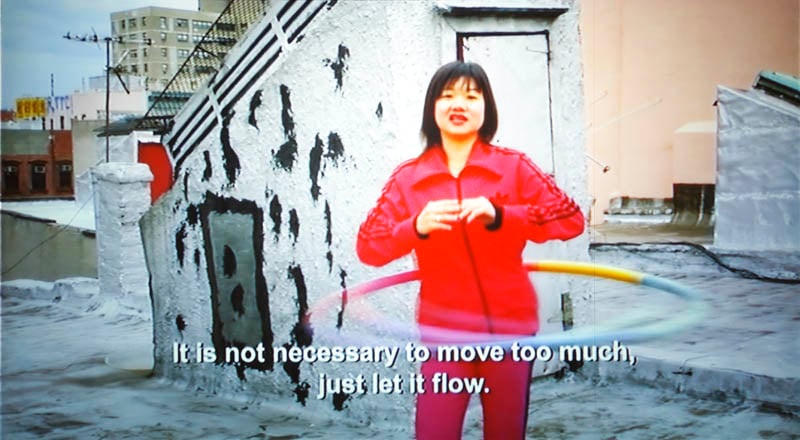
© » KADIST
Christian Jankowski
In New York City’s Chinatown, subject Suat Ling Chua’s morning exercise is to practice the hula hoop. When Christian Jankowski first saw this woman he immediately got the idea to shoot Rooftop Routine . In the short video, Chua leads the group and dictates the movements that each participant has to repeat.

© » KADIST
Clemens von Wedemeyer
Silberhöhe , directed at Halle, located in the former GDR (German Democratic Republic), is the name of a neighborhood on the outskirts of the city, which was built in the 70’s and could accommodate more 40,000 people. The opening of the film presents us with a dramatic process that transforms the documentary image. The lack of human presence makes creates a strange atmosphere in the film.

© » KADIST
Martin Kippenberger
Drawing & Print (Drawing & Print)
7″ Single ‘Pop In’ by Martin Kippenbergher consisting of a vinyl record and a unique artwork drawn by the artist on the record’s sleeve. In the foreground of the album’s cover, a drawing of an empty, round vessel is framed underneath the text “POP IN”, suggesting an invitation to listen to the record, a nod to pop music, or perhaps a literal proposal to enter the vessel or the work. In the background, partly hidden by the round form, Kippenberger’s hand-drawn self portrait glares back at the viewer.

© » KADIST
Annette Kelm
In Stilleben mid Zierlauch ( Still Life with Aluminum) Annette Kelm utilizes visual juxtaposition to bring together a gridded aluminum backdrop, a pot with a vaguely indigenous pattern on it, and two purple dandelions. The aesthetic dissonance between the mechanical, gridded aluminum and the grainy clay pot signify an interaction between systems of visual production, furthered by the aluminum grid’s inward tilt, visually apparent due to the grid pattern’s convergence at the top of the photograph. Contrasting the stark slant of the grid, the pot sits on a level surface, while the two tall stems protruding from it run at a non-parallel angle to the grid.
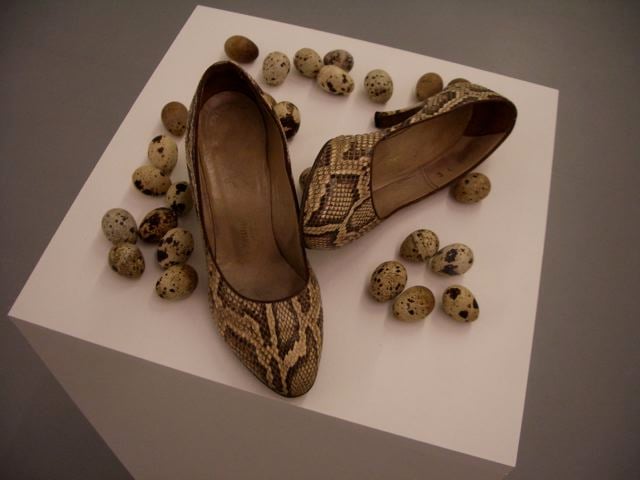
© » KADIST
Hans-Peter Feldmann
The types of objects Feldmann is interested in collecting into serial photographic grids or artist’s books are often also found in three dimensional installations. Verging on a form of fetichism, his shoe collections are a case in point and indeed, for some exhibitions, he even asked gallery employees for their shoes. Against authorship and the commodification of art, he never gives titles or dates to his works which have infinite edition possibilities.

© » KADIST
Kota Ezawa
The Crime of Art is an animation by Kota Ezawa that appropriates scenes from various popular Hollywood films featuring the theft of artworks: a Monet painting in The Thomas Crown Affair (1999), a Rembrandt in Entrapment (1999), a Cellini in How to Steal a Million (1966), and an emerald encrusted dagger in Topkapi (1964). Ezawa uses his signature cartoon-like style to remix and reenact these crime scenes, leaving only the artworks as “real” objects (as they are depicted in the films), rather than illustrating them. Reversing fiction and reality in an unexpected way, this gesture invites the viewer to question the reliability of the visual footage.
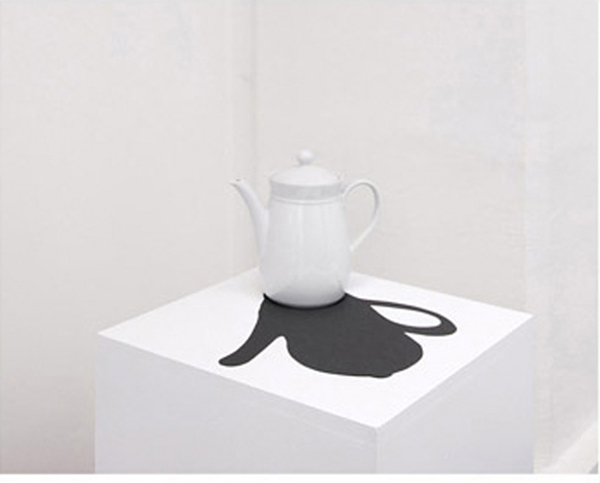
© » KADIST
Hans-Peter Feldmann
The types of objects Feldmann is interested in collecting into serial photographic grids or artist’s books are often also found in three dimensional installations. Against authorship and the commodification of art, he never gives titles or dates to his works which have infinite edition possibilities. This mise en scène of found kitchenware also exists with a rounder and flatter plain modern white porcelain teapot.
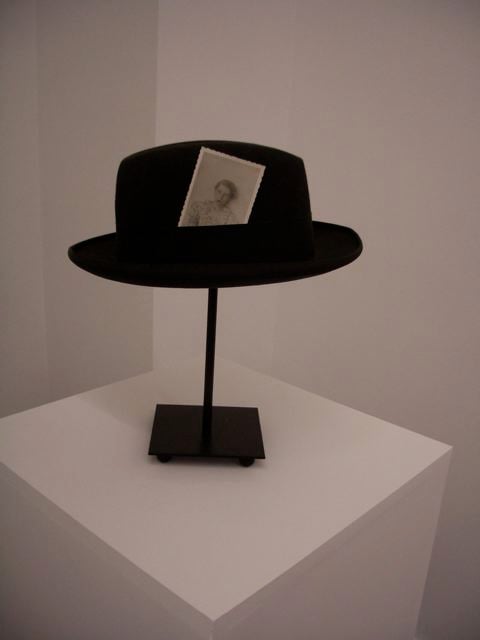
© » KADIST
Hans-Peter Feldmann
The types of objects Feldmann is interested in collecting into serial photographic grids or artist’s books are often also found in three dimensional installations. Hats and photographs are regularly part of his appropriations and arrangements. He famously made numerous trips to England in search of old photographs when he was an antique dealer, and then worked in a gift store with his wife when he left the art world in the 1980s.
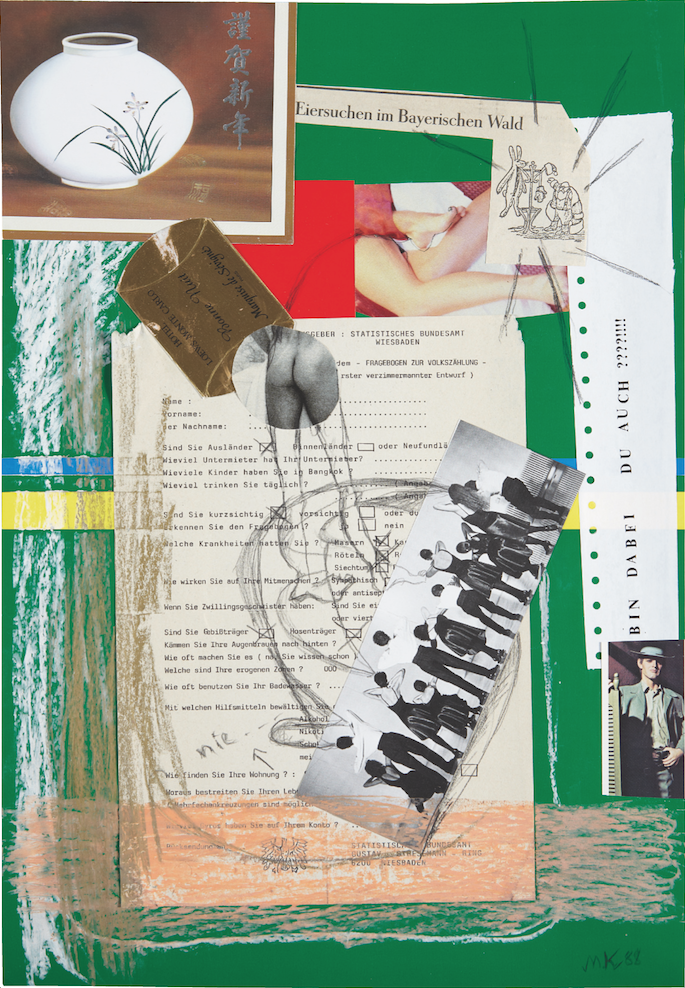
© » KADIST
Martin Kippenberger
Martin Kippenberger’s late collages are known for incorporating a wide range of materials, from polaroids and magazine clips to hotel stationery, decals, and graphite drawings. Untitled is a collage on paper work by Kippenberger that typifies his everything-goes approach: a barely discernible, sliced image of Michael Jackson’s face is overlaid and woven with strips and triangular shapes from a different source into a single composition. Blue tones come from torn out pages of a book where fragments of illustrations can be seen.

© » KADIST
Martin Kippenberger
Drawing & Print (Drawing & Print)
Untitled is a work on paper by Martin Kippenberger comprised of several seemingly disparate elements: cut-out images of a group of dancers, a japanese ceramic vase, and a pair of legs, are all combined with gestural, hand-drawn traces and additional elements such as a candy wrapper from a hotel in Monte Carlo and a statistical form from a federal government office in Wiesbaden, Germany. Text cut out from a Newspaper spells out in German “Egg hunting in the Bavarian forest” and an additional piece of text reads in all capitals “BIN DABEI DU AUCH” (“I’m here too” in English). Together, all the messages and geographies from the separate elements suggest an alternative, highly stylized portrait of the artist; in this case, a fragmented, fluid, and itinerant sense of identity.
Kota Ezawa
- location: San Francisco, California
- year born: 1969
- gender: male
- nationality: German
- home town: Cologne, Germany
Hans-Peter Feldmann
- location: Düsseldorf, Germany
- year born: 1941
- gender: male
- nationality: German
- home town: Dusseldorf, Germany
Martin Kippenberger
- location: Vienna, Austria
- year born: 1953
- gender: male
- nationality: German
- home town: Dortmund, Germany
Clemens von Wedemeyer
- location: Göttingen, Deutschland
- year born: 1974
- gender: male
- nationality: German
Thomas Kilpper
- location: Stuttgart, Deutschland
- year born: 1956
- gender: male
- nationality: German
Annette Kelm
- location: Stuttgart, Deutschland
- year born: 1975
- gender: female
- nationality: German
Ulla von Brandenburg
- location: Karlsruhe, Deutschland
- year born: 1974
- gender: female
- nationality: German
Christian Jankowski
- location: Göttingen, Deutschland
- year born: 1968
- gender: male
- nationality: German
Wolfgang Tillmans
- location: London & Berlin
- year born: 1968
- gender: male
- nationality: German
- home town: Remscheid, Germany
-
1980-1989
Martin Kippenberger
1988Martin Kippenberger’s late collages are known for incorporating a wide range of materials, from polaroids and magazine clips to hotel stationery, decals, and graphite drawings...
Martin Kippenberger
Drawing & Print
1989(Drawing & Print) 7″ Single ‘Pop In’ by Martin Kippenbergher consisting of a vinyl record and a unique artwork drawn by the artist on the record’s sleeve...
Martin Kippenberger
Drawing & Print
1989(Drawing & Print) Untitled is a work on paper by Martin Kippenberger comprised of several seemingly disparate elements: cut-out images of a group of dancers, a japanese ceramic vase, and a pair of legs, are all combined with gestural, hand-drawn traces and additional elements such as a candy wrapper from a hotel in Monte Carlo and a statistical form from a federal government office in Wiesbaden, Germany...
-
2000-2009
Kota Ezawa
2002The Simpson Verdict is a three-minute animation by Kota Ezawa that portrays the reading of the verdict during the OJ Simpson trial, known as the “most publicized” criminal trial in history...
Clemens von Wedemeyer
2003Silberhöhe , directed at Halle, located in the former GDR (German Democratic Republic), is the name of a neighborhood on the outskirts of the city, which was built in the 70’s and could accommodate more 40,000 people...
Clemens von Wedemeyer
2004Die Siedlung is a filmic documentary about the recent shift in housing developments in Leipzig-Grünau in former East Germany and its consequences on some inhabitants...
Ulla von Brandenburg
2007Eight opens with a close up of a painting by Hubert Robert of the Chateau de Chamarande where the film was shot...
Christian Jankowski
2008In New York City’s Chinatown, subject Suat Ling Chua’s morning exercise is to practice the hula hoop...
Thomas Kilpper
Drawing & Print
2009(Drawing & Print) These two images come from the series called “State of Control” which Kilpper made in the building formerly occupied by the Stasi in Berlin...
Thomas Kilpper
Drawing & Print
2009(Drawing & Print) These two images come from the series called “State of Control” which Kilpper made in the building formerly occupied by the Stasi in Berlin...
-
2010-2019
Annette Kelm
Drawing & Print
2013(Drawing & Print) Percent for Art is seemingly concerned with “art enrichment” by state or city arts agencies role in it, managing the artist rosters, maintaining public art collections, commissioning artworks, selecting installation sites, among other things for aesthetic and cultural enhancement in both public and private real estate developments...
Kota Ezawa
2014Paint and Unpaint is an animation by Kota Ezawa based on a scene from a popular 1951 film by Hans Namuth featuring Jackson Pollock...
Annette Kelm
2014In Stilleben mid Zierlauch ( Still Life with Aluminum) Annette Kelm utilizes visual juxtaposition to bring together a gridded aluminum backdrop, a pot with a vaguely indigenous pattern on it, and two purple dandelions...
Wolfgang Tillmans
2017Wolfgang Tillmans initiated the ongoing series Faltenwurf in 1989, representing compositions of unused clothing, with special attention paid to the ways in which they drape and fold...
Kota Ezawa
2017The Crime of Art is an animation by Kota Ezawa that appropriates scenes from various popular Hollywood films featuring the theft of artworks: a Monet painting in The Thomas Crown Affair (1999), a Rembrandt in Entrapment (1999), a Cellini in How to Steal a Million (1966), and an emerald encrusted dagger in Topkapi (1964)...